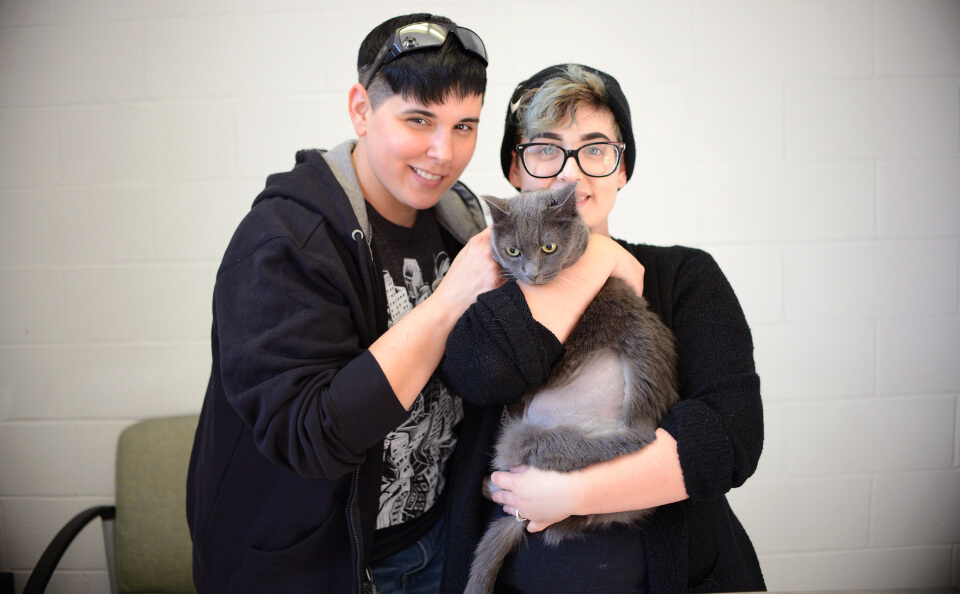Church wasn’t acting like herself. The 13-year-old gray cat, named for her doppelgänger in the film Pet Sematary, was drinking more water than usual and was abnormally excitable. Her devoted owners, Lauren Catullo and Rianna Taylor, noticed the changes immediately. Thankfully, Church’s yearly veterinary exam was right around the corner.
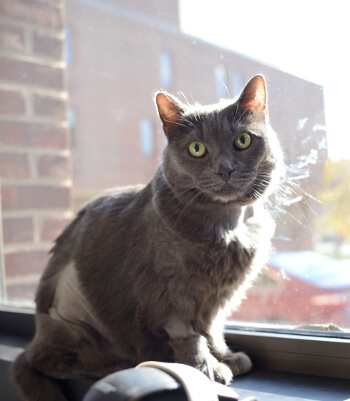 “We always run a senior blood profile, so I was hopeful that we’d have some answers,” said Catullo. And they did.
“We always run a senior blood profile, so I was hopeful that we’d have some answers,” said Catullo. And they did.
Results showed that Church had hyperthyroidism, a common condition in middle-aged and older cats. Church’s symptoms were among the typical clinical signs: weight loss, increased appetite, and increased thirst and urination. Some cats also experience vomiting, diarrhea, hyperactivity, and mood changes.
Catullo and Taylor started Church on methimazole, a drug used to treat hyperthyroidism. Unfortunately, relief was not yet on the way for their much-loved cat.
A Different Approach
A few days after starting the methimazole, Church stopped eating and drinking and vomited frequently.
“We were really concerned,” said Catullo. “We brought her right back to our veterinarian.”
They soon discovered that Church was experiencing serious side effects from the drug and would not be able to continue that course of treatment. If left untreated, Church could experience severe complications, including heart failure, kidney damage, and even death.
Much to their relief, Catullo and Taylor learned about another treatment option, I-131 therapy. With just a single shot of radioactive iodine, Church could be cured of the disease. But only a few veterinary hospitals in the region are licensed and equipped to administer the radiation. Penn Vet’s Ryan Hospital is one of them.
“It was an easy decision to pursue this therapy at Penn Vet,” said Catullo. “We want Church to be around for another 10 years. We’ll do whatever we can to make her life happy and long.”
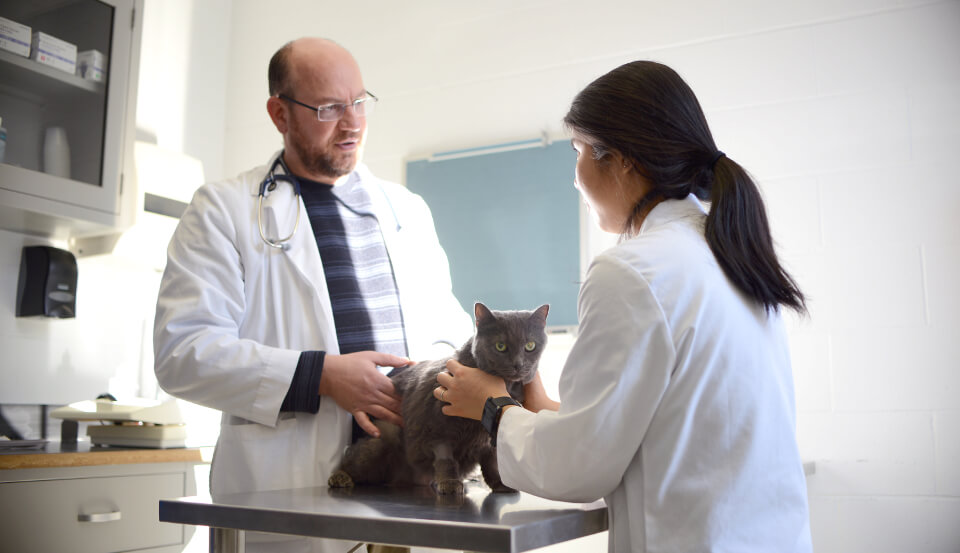
At Ryan Hospital a week later, Catullo and Taylor met with Dr. Ariel Mosenco, Clinical Associate Professor of Medicine, and Ali McKenna, a board-certified veterinary technician. Mosenco assured them of the treatment’s safety and clarified some misconceptions: “It’s less aggressive than taking blood. It’s not a surgery. It doesn’t require anesthesia. And it’s not painful for Church.”
Thanks to a series of tests performed by Church’s primary care veterinarian, Church was deemed a good candidate for I-131, having no signs of systemic disease or kidney disease.
One and Done
Two weeks later, Mosenco and McKenna donned plastic gowns and boots, gloves, and eye protection. It was time for Church’s treatment. The well-behaved cat barely stirred as she received the injection, administered under the skin like a vaccination. The entire procedure took less than two seconds.
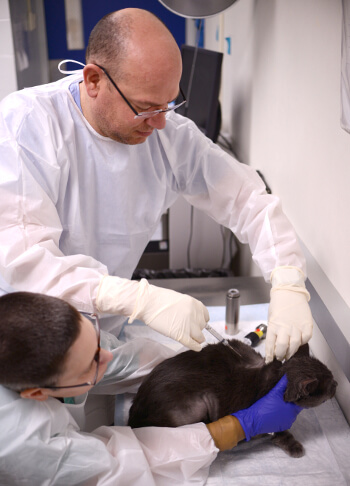 Following the injection, the radioactive iodine is absorbed by the thyroid gland. The I-131 destroys the thyroid cells, decreasing the amount of thyroid hormone the gland releases.
Following the injection, the radioactive iodine is absorbed by the thyroid gland. The I-131 destroys the thyroid cells, decreasing the amount of thyroid hormone the gland releases.
In approximately 95 percent of cases, the disease is cured after a single injection.
Monday through Thursday of that week, Ryan Hospital served as Church’s temporary home away from home. McKenna checked on her regularly, monitoring radiation levels and making sure she was comfortable.
“I visited Church several times a day to give her fresh food and clean litter and to check on her wellbeing,” said McKenna.
“We do as much as possible to make cats comfortable in this environment during their four-day stay,” continued McKenna. The cats stay in a separate room of the hospital with individual cages equipped with sleeping ledges and separate litter box areas. Calming music plays at all times. In addition, owners can bring food and bedding from home, with the understanding that those items cannot be returned because of possible exposure to radioactivity. Penn’s Office of Environmental Health and Radiation Safety disposes of all radioactive materials and waste from the room.

During her check-ins, McKenna used a Geiger counter to measure Church’s radiation levels. When the levels were low enough on Thursday, Church was allowed to return home.
“I called Lauren and Rianna each morning to provide them with updates. I was happy to report that Church was a model patient,” said McKenna. “They were very excited to pick her up on Thursday.”
Advantages
There are many advantages to I-131 treatment. “For starters, it is much easier than having to pill your cat twice a day, every day, for the rest of its life,” said Mosenco.
Most cat owners can attest to the difficulties of pilling a cat. “Cats get scared and hide and often run when their owners come near them, whether they are trying to pill them or not,” continued Mosenco. “This can disturb the bond between cat and owner.”
As a result, compliance also can be a challenge. According to Mosenco, studies have shown that compliance is only around 40-50 percent for cat treatments that require long-term pilling.
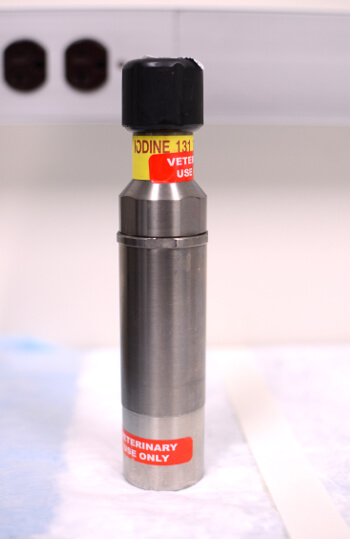 “I imagine that for the cats, it is so much nicer to have just a few days away from home rather than get a pill every day,” said McKenna. “I’m pretty conservative with the treatments I would give my cats, but I would do this in a heartbeat.”
“I imagine that for the cats, it is so much nicer to have just a few days away from home rather than get a pill every day,” said McKenna. “I’m pretty conservative with the treatments I would give my cats, but I would do this in a heartbeat.”
Another downside of methimazole is the potential side effects. Approximately 25 percent of cats experience vomiting and diarrhea, which can sometimes be severe, as in Church’s case. Other cats experience liver toxicity, immune-mediated disease, and facial excoriation as the result of itchy skin. In these extreme cases, the medication must be discontinued immediately.
I-131 treatment can offer financial benefits over time, as well. Patients on methimazole must return to their veterinarian regularly for re-checks. Add that to the cost of the medication for the remainder of the cat’s life, and the one-time fee for I-131 treatment offers savings in the long run.
There are very minimal side effects, if any, from I-131 treatment. Approximately 5 percent of cats may require a second injection. And approximately 5 percent of cats experience hypothyroidism following treatment.
“Studies have shown that cats treated with I-131 live longer than those treated with pills,” added Mosenco, citing a study where I-131-treated cats lived an average of four to five years following treatment, versus an average of only two years for cats on medication.
Home for the Holidays
Safety regulations remained in place for Church, even after leaving Ryan Hospital.
Because the radioactivity is excreted in the urine, feces, and saliva of treated cats, they must be quarantined for two weeks until the majority of the radioactivity is eliminated.
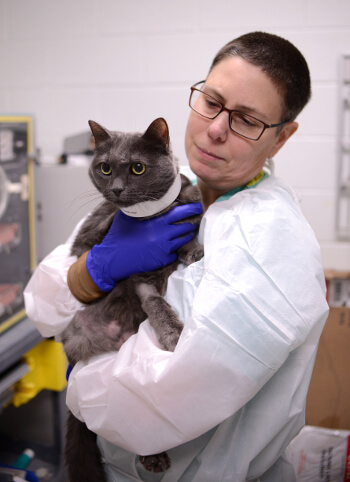 In addition, Catullo and Taylor were instructed to use flushable litter and minimize Church’s contact with humans and their other cats during the two-week period.
In addition, Catullo and Taylor were instructed to use flushable litter and minimize Church’s contact with humans and their other cats during the two-week period.
“Church lived in our spare bedroom during that time,” said Taylor. “We took extra precautions and followed the rules very carefully. Church couldn’t wait to get out of the confinement of one room to go play with her buddies.”
Church was allowed to rejoin the family—including her feline siblings—on December 21, just in time for the holidays.
“I’m so thankful,” added Taylor. “She’s eating, she’s drinking, she’s alert, and she’s affectionate. She returned to her normal self so quickly. It’s exceptional.”
Church will return to Ryan Hospital in January for blood work to check her thyroid levels.
“This was the best treatment for Church,” said Taylor. “Seeing how sick she got from the medication and seeing her now took a lot of weight off our shoulders. There weren’t any side effects from the I-131. It was really miraculous! And it made us feel confident that we made the right decision for Church.”
“Hyperthyroidism is a disease we need to treat,” said Mosenco. “It’s wonderful to deal with treatment that provides a cure. To see cats come back for re-checks and the owners are very happy, the cat is gaining weight, and acting normal again – that’s why we do what we do. It’s very rewarding.”
